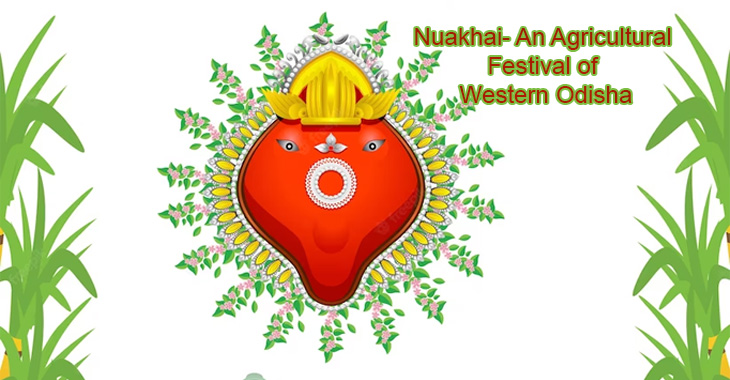The majority of Western Odisha residents in India observe the agricultural festival known as Nuakhai. It is customary in Nuakhai to welcome the new rice harvest.
Other names for Nuakhai are Nuakhai Parab and Nuakhai Bhetghat. The name indicates that the farmers are in possession of just harvested rice because nua means new and khai means food. According to the calendar, it is celebrated the day after Ganesh Chaturthi on panchami tithi (the fifth day) of the lunar fortnight of the month of Bhadrapada or Bhadraba (August-September). This is Western Odisha’s most significant social celebration. Western Odisha has a lot more pronounced culture since there are so many things to learn about both agriculture and human behavior, and nuakhai is a very significant celebration.
It is the Western Odisha population’s agricultural celebration. Although the event is observed across the entire state of Odisha, it is especially significant to the way of life and culture of Western Odisha. It is a holiday dedicated to the veneration of grain. The finest celebrations take place in the Odisha districts of Kalahandi, Balangir, Bargarh, Sundergarh, Jharsuguda, Sambalpur, Subarnapur, Boudh, and Nuapada.
The celebration, which takes place the day following Ganesh Chaturthi, is viewed as a new sign of hope. For farmers and the agricultural community, it is very important. The celebration known as lagan is observed at a specific time of day. For this festival, Aersaa Pithaa is prepared. The locals recall their village deity or goddess before having their khai when the lagan arrives.
How it Celebrated?
About 15 days before the event, the senior residents of the hamlet gather at a sacred site to begin preparations after the beheren summons them with a trumpet. Then everyone gathers to debate the tithi and lagna for Nuakhai with the priests.
Both domestically and in the society, Nuakhai is a holiday. The first place the rites are performed is at the temple dedicated to the village deity or the area’s ruling deity. After that, everyone practices devotion in their own houses, performing rituals for both their personal deity and Lakshmi, the Hindu goddess of riches. For the event, people don new clothing. It is tradition for the eldest family member to distribute nua to the other family members after presenting it to the presiding deity. All of the family’s younger members bow to their elders after taking the nua.
The senior citizens bless the younger people and wish them health, happiness, and wealth. Even the brothers who are divided up celebrate the occasion together. Folk songs and dances known as “Nuakhai Bhetghat” are organized in the evening. Folk dances from Sambalpur, such as Rasarkeli, Dalkhai, Maelajada, Chutkuchuta, Sajani, Nachnia, and Bajnia, are danced to.
As Western Odisha residents gather and share in the celebration of Nuakhai, Nuakhai serves as a unifying and cohesive factor in Delhi. Since a few decades ago, Odia immigrants who now reside in Rajasthan, Bangalore, Bhopal, Chennai, Hyderabad, Kolkata, Mumbai, Surat, and Visakhapatnam have celebrated Nuakhai in their new cities.
Which Places People visits most:
On this occasion, people visiting the Nuakhai shrines in Western Odisha include:
Samaleswari Temple, Sambalpur – The Nabanna Lagi ceremony of Nuakhai is well-known in the Samaleswari Temple in the Sambalpur area.
Kalahandi’s Maa Manikeshwari Temple – Following this Nuakhai rite, thousands of devotees assemble to pray to Maa Manikeshwari, the deity who rules over Bhawanipatna.
Kosaleshwari Temple, Titlagarh – Maa Kosaleswari is a Shakta cult figure and is highly revered during the festival of Nuakhai in this temple.
Sureswari Temple, Sonepur – In the temple town of Odisha’s Subarnapur district, Nuakhai is offered to Maa Sursuri, one of the earliest Shakti shrines.
The primary deity of Maa Pataneswari, the first Chauhan King Ramai Dev, is worshipped in the Pataneswari Temple in Balangir, which is located 40 kilometers from the city.
People Offer Nuakhai Bhog:
The following meals are frequently served as part of the Nuakhai bhog:
Rice leaves are used to make the cuisine patra poda, which is filled with a coconut, spice, and vegetable mixture.
Vegetables, rice, and lentils are used to make the dish dalma.
A recipe for chhena poda calls for cottage cheese, herbs, and veggies.
Rice, milk, and sugar are used to make the sweet dessert kheer.
Fried bread is called puri.
A sweet dish called chhena jhili is prepared with cottage cheese and sugar.
Rasagola, jalebi, and payas are a few additional classic Odia foods that could be a part of the Nuakhai bhog.
Conclusion
Nuakhai is a season of joy and gratitude for the fresh harvest. Families and communities can join together during this time to celebrate their culture and heritage. It is observed on Wednesday, September 20, this year. For the people of Odisha, Nuakhai is a time of great delight and celebration. It’s a moment to rejoice in their culture and heritage and express gratitude for the fresh harvest.
Read More
Chandrayaan-3: India conquered the Moon’s South Pole
Puri Rath Yatra: PM Modi and President Murmu welcome pilgrims on the Jagannath Rath Yatra


